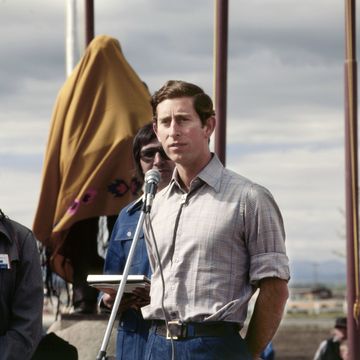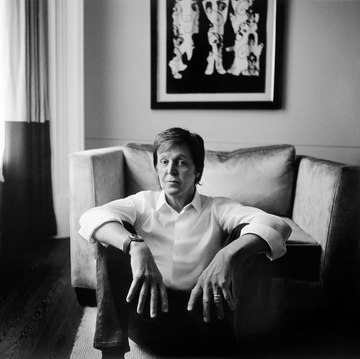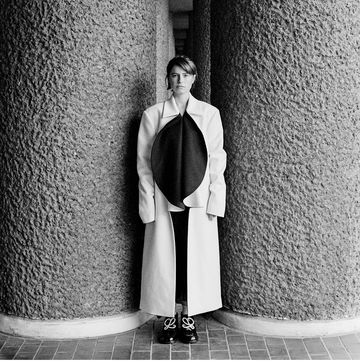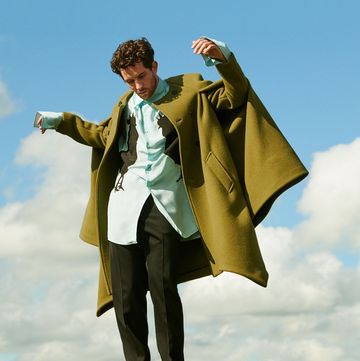'Ugly are hornless bulls, a field without grass is an eyesore, so is a tree without leaves, so is a head without hair.'
Ovid, Ars Amatoria (c. 2AD)
Nora Ephron once said height is to men what breasts are to women. "I disagree," responded American magazine editor Art Cooper. "I think it's baldness. I think men are more concerned about their hair than anything else. No one wants to be bald. They don't want to look like Sean Connery unless they can have all the rest that goes with being Sean Connery."
Cooper was speaking in 1986. Thirty years later, we have the stats to back him up. According to Google, last year there were six per cent more searches for men's hair than for women's, something partly attributed to trends like the "man bun".
No one wants to be bald. The associations are almost always negative. In one academic study, people were shown sketches of men and asked to rate them based on first impressions. The bald men rated as the most unkind, ugly and "bad". Another survey questioned women aged 21 to 35 in cities across America. Sixty-five per cent thought bald men were less virile, 77 per cent thought they had less sex appeal, 75 per cent thought they were less intelligent and the same number thought they looked older than their ages.
"The greater the hair loss, the greater the psychological cost," says psychologist Thomas Cash, quoted in Kerry Segrave's book Baldness: a Social History. His own survey concluded that baldness made for a terrible first impression, with respondents rating balding men as less physically active, less self-assertive, less socially attractive, less likely to experience success in both their personal and professional lives and less liked than their non-balding counterparts. Yet another study — 'The Hairiness and Large Penis Stereotypes' — suggested a positive correlation between hairiness and penis size.
Most CEOs have hair. The last British prime minister with significant hair loss was Winston Churchill while America hasn't elected a bald president for 60 years. Discount Michael Stipe (who still had hair when he became famous) and you'll struggle to name a bald rock star. Baldies tend to do better in the movies but only if they're villains: Don Logan in Sexy Beast, John Doe in Se7en, Dr Szell in Marathon Man, Mola Ram in Indiana Jones and the Temple of Doom, Freddie Kruger, Darth Maul, Gollum, Pinhead, Voldemort, Bane, Blofeld, Lex Luthor, Ming The Merciless, Dr Evil… the list goes on. Sean Connery, a baldie pioneer, asked if he could play one of his final Bonds without his hairpiece. They turned him down.
In The Simpsons episode "Simpson & Delilah", Homer successfully tries out a miracle hair restorer. Reporting to work as usual the next day, Mr Burns is impressed.
"Wait. Who is that young go-getter?"
"Well, it sort of looks like Homer Simpson, only more dynamic and resourceful," Smithers tells him. Simpson is then promoted to junior executive and given a key to the executive washroom.
The oddity is that 25 per cent of men at age 25 are already losing their hair. By age 50, half the population are. By 60, we're up to 75 per cent. I started going bald in my twenties. I remember looking in the bathroom mirror at university and thinking "Uh-oh" — the first signs of widow's peak. Men commonly report feeling traumatised and threatened by hair loss and I suppose I was no different. Then came the baseball cap years. The problem with being a bald man wearing a hat is that you look like a bald man wearing a hat. No one thinks The Edge, that Coldplay guitarist or Garth Brooks are secretly harbouring long flowing locks. Plus, not everyone can wear a Stetson to work. So what's a man to do? If Elton John's hair is the best that money can buy, it seems pointless to even consider artificial options. In 2016, we can put a man on the International Space Station but we still can't manufacture a decent head of hair.
Still, we're happy to spend our money trying. The various pate-covering technologies (weaves, plugs, creams) are estimated to be worth $3.5bn (£2.44bn) every year in America alone. Yet it remains a furtive business. In an age where Pelé can front adverts for erectile dysfunction and actors speak openly about plastic surgery, wearing a wig may be the last cosmetic taboo. In this regard, gender equality still has some way to go. Women are always complimenting one another on their fake nails, hair extensions, tans, waxes, whitened teeth, boob jobs, high heels, make-up etc, but it's an unusual kind of man who'll shout about his new hairpiece. Yet male pattern baldness is more than a condition in need of cosmetic correction: it's a disease, classified as such by the World Health Organisation in 1992. Why do wigs and toupees remain a joke? A source of mirth from Laurel and Hardy to Seinfeld, they're always getting yanked off some unsuspecting and pompous (they're always pompous) wearer's head, usually to the sound of a swannee whistle. George Cruikshank was an early proponent of the war on rugs: one of his 1837 illustrations shows a toupee-wearer being embarrassed by a strong gust of wind.
"The problem is that historically, male vanity is seen as a weakness," says Mark Simpson, a journalist and writer who specialises in masculinity. "And when it comes to men and weaknesses, whether it's hair or sex, we like to snigger. It's an opportunity for banter and insult. Also, we're coming out of
a period where masculinity had to be authentic, it had to be the real thing. By contrast, femininity was masquerade. So many Hollywood films are based on the idea of femininity as masquerade and masculinity as action: men who impose themselves on the world, rather than submitting to it. The thing about wigs is they're the height of artifice."
Simpson, who happily labels himself "slapheaded", cites the rise of the shaved head as a method for minimising the effects of baldness as a turning point for men. "It became an acceptable way for a mature male to present himself. To own the fact he was balding and make it into a style. It marked the end of the combover. Gay culture and youth culture converging in the Eighties is where it started, but actually I think Bruce Willis did a lot to popularise it."
It wasn't always the way. Business was booming for men's wigs back in the day, even if that day ended in the 18th century. The earliest recorded toupee was found in a tomb near the ancient capital of Egypt and dates from 3100BC. King Louis XIV of France — bald at 27 — ushered in the European craze for men's wigs when he employed 48 personal wig makers. Wearing a wig became a mark of status (hence the term "bigwig"), so much so that men started powdering their own hair to get in on the act. William Andrews, a 19th century English writer, tells us that wig theft on the streets was not uncommon. One method involved a boy carried over a butcher's tray by a tall man; the boy would then reach out and snatch hairpieces from the heads of unsuspecting owners.
By the mid-Fifties, a Hollywood survey indicated that 10 per cent of male actors over 35 wore a toupee. In the Hollywood Museum today, there exists a toupee hall of fame displaying hairpieces that once belonged to Frank Sinatra, Fred Astaire, James Stewart and Gene Kelly. In New York there existed a barber specifically for bald men: customers would have their hairpieces tended to while sitting behind a discreet screen. By 1970, Time magazine estimated that toupees were worn by 2.5m men in the US.
On the one hand, you imagine the wig's glory days are behind it, petering out sometime in the Seventies. On the other, perhaps the reason they're not as noticeable today is because they've got better. When it comes to my own head, I've long since given up caring. I'm 44 with two kids. My wife says she's glad I'm bald. I already spend too long getting ready, she says: if she had to add hair time too she'd have walked out the door and met someone else. And yet… wouldn't it be nice to feel some hair on my head again? So that my daughter stopped calling me "Gru" in front of her friends? So that people at work no longer got me mixed up with "the other one" in the office (if we were Asian, surely HR would want to hear about this?). So that I'd be back on a level playing field with everyone else, socially and economically, if all those surveys are to be believed? If there was some easy fix, something to turn back the clock, where I had new hair that really looked like my old hair, hair that no-one could tell wasn't mine… wouldn't I take it? No one wants to be bald.
So I came up with a challenge. I would find the best toupee money could buy. I would spend a fortnight wearing it. And I would see what difference it made to my life.
'I'm not getting a wig! It's like a woman wearing false pretences.'
Eric Morecambe to Ernie Wise, Two of a Kind (1963)
The fanciest toupee maker I can find is Mandeville Wigs in London. Its website says it produces "the UK's finest bespoke real European human hair wigs". Its prices are reassuringly expensive. I get in touch and explain the idea. Come and see us, I'm told.
Mandeville's offices are in a collection of studio spaces in Fulham. Its neighbours are yacht designers, luxury travel companies and publishers. It's a discreet operation, just Mandeville on the door. Inside, I meet Robert Frostick, one of the company's directors. He's a hairdresser who used to work in the film and music business. He did Peter Sellers and Julie Christie's hair, and the mod cuts on The Jam's first album.
"It's going to be a bit of a transformation," he says, examining my shaved head.
He explains I have two options. They can make me a full wig, or they can make me a hairpiece that would blend in with what's left of my own hair. Their preference is the latter. But it comes with consequences. It would mean I'd have to grow my hair — the back and sides. Initially so they can get a good colour match to make the wig, and then so the two will join together. This means cultivating the Friar Tuck-style haircut you rarely see these days: like the singer James Taylor or Bill Dauterive from King Of The Hill. Given that I shave my head with clippers every couple of days, this is not news I welcome.
"How long for?" I ask. "Couple of weeks?"
"Average hair growth is half an inch a month," Frostick says. "So, two months?"
"We're going for realism," Frostick continues. "We want you to walk into a hairdressing salon and a hairdresser will say, 'What can I do for you?' That's what the response should be."
The first stage is to make a template of my head. "I'm going to take him upstairs," says Frostick. At the top of the building is the studio. I sit in a barber's chair facing the mirror.
"I'm going to wrap your head in clingfilm," Frostick says. Then he covers my clingfilmed head in Sellotape, pulling it tight to better make an impression. "We tried lots of things but the old clingfilm is the best way to do it," he explains.
At this stage, with Frostick and his co-director Joanna Pickering sitting either side of me, and my head encased in plastic wrap and taped, it crosses my mind that they're about to do me in. I try and remember who knows I'm here.
"Everything is handmade from start to finish," Frostick explains. Unlike male wigs of the Seventies that were so big they came with metal support bands that would set off metal detectors at airports, the foundation of the wig is a superfine microfibre mesh that weighs less than a gram. Into this approximately 40,000 human hairs will be knotted, each one by hand. It's something like 250 hours' work. The cost: £2,770 plus VAT. (Unlike treatments for female pattern baldness, which come VAT exempt, men have to pay — more discrimination.) Then I'll need a wig block to store it on, a special brush and some shampoos; another couple of hundred quid. The piece should last 18 months, depending on how well it's treated.
Of the origins of their hair, Mandeville are vague. "It's northern European hair," says Frostick. "We get a lot of hair from the northern Baltic states."
Many of Mandeville's clients come for medical reasons such as alopecia, or they've been diagnosed with cancer. "Really, the next step on from their oncologist is to come here," says Mandeville's general manager Rick Cunningham. "Basically, they've only just found out about their condition. So one has to be really sensitive. It's a huge thing."
Whatever the reason, people tend to leave Mandeville happier than when they went in. "It's amazing," Cunningham says. "The lady who sits on reception remarks on the difference between people coming in here for the final fitting and going out. They come out with their head held higher, a big smile on their face."
When I return two months later, back and sides grown out, Frostick spends some time examining my hair. "It's that old English mousey colour," he decides. They fetch some stock hair and start comparing samples, eventually settling on a blend of two shades. "That's spot on," approves Pickering.
It'll take another two-and-a-half months to make the piece, then I'll be asked back for a fitting. "Don't cut your hair," Frostick calls after me.
According to Baldness: a Social History, bald prejudice dates back at least as far as The Bible, where it was directed at the prophet Elisha. From the second Book Of Kings, Chapter 2: "And he went up from thence unto Bethel: and as he was going up by the way, there came forth little children out of the city, and mocked him, and said unto him, 'Go up, thou bald head; go up, thou bald head.' And he turned back, and looked on them, and cursed them in the name of the Lord." Egyptian kings retained bald jesters, the better to poke fun at them.
The Romans were notable baldists. Bald slaves had their duties restricted to cleaning toilets, stables and gutters: anything more was considered above them. Julius Caesar was so sensitive about the image of frailty his thinning hair supposedly projected he took to wearing his famous laurel leaves in disguise. "You collect your straggling hairs on either side, Marinius," wrote the Roman poet Martial, to a friend. "Endeavouring to conceal the vast expanse of your shining bald pate by the locks which still grow on your temples. Why not confess yourself an old man? There is nothing more contemptible than a bald man who pretends to have hair."
Samuel Johnson argued bald people were unintelligent, writing in 1778: "The cause of baldness is dryness of the brain, and its shrinking from the skull." Then after Napoleon's army froze to death following its disastrous 1812 offensive against Russia, his chief surgeon reported that it was the bald soldiers who succumbed to the cold first: promoting the idea bald men are weaker than others.
The first recorded "cure" for baldness dates back to 1500BC and was a paste comprising the fat of a lion, hippopotamus, crocodile, cat, serpent and goat, to be rubbed into the bald scalp. Another involved the toes of a dog, a "refuse" of dates and the hoof of an ass. Sunlight, water, eating meat, indigestion, alcohol and tobacco, ice cream, lack of faith, anxiety, sex, hats, the wrong sort of breathing and maternal grandfathers have all been held responsible for baldness over the years.
In fact, baldness is down to a combination of hereditary factors and hormones, one that we still don't fully understand. It is most likely that multiple genes contribute to male pattern baldness, the most important of which is located on the X chromosome and inherited from the mother. However, both parents contribute to their offspring's likelihood of hair loss, in conjunction with the hormone dihydrotestosterone, a derivative of testosterone, known as DHT. In genetically-prone scalps, DHT shrinks hair follicles until they eventually go dormant and give up producing hair completely.
There is only one guaranteed way of ensuring you don't go bald, but it's not for everyone. Before puberty, you need to have your testicles removed. Men who fail to mature sexually do not go bald. This was evidenced by a series of 1942 experiments on eunuchs by the anatomist James Hamilton. He noted that adult eunuchs castrated before puberty never went bald, while adult eunuchs castrated in adulthood had their hair loss halted. (The castrated, balding eunuchs were then injected with testosterone, with the result that their hair loss continued.) Like I said, it's not for everyone.
'Good looks can open doors. Good hair blows them off the hinges.'Sam Malone, Cheers (1990)
Robert Frostick had asked me to bring some old photos with me when I went back to Mandeville. He wanted to see what I looked like with hair. That way he could fit the wig as realistically as possible. I was aged 19 in the first one.
"You're like that geezer in Friends!" he says. "Chandler! When he lost weight."
There are a couple more in my mid-twenties. "God, that's really sad, actually," he says. He means how much hair I've lost. "It's such a short time," he explains.
He produces the finished hairpiece, a floppy mesh of locks in the aforementioned old English mousey colour. It really does look like my hair.
"Brilliant match, isn't it? The colour," he says. "We put a few white ones in there for you as well."
He shows me how to wear it. A thin strip running round the underside is where you attach a dozen-or-so half-inch pieces of double-sided tape. "You find your hairline then you literally peel it on," he says.
We try it out. I had expected it to have a weight to it, imagining a dressing-up wig from a joke shop. In fact, it's only as heavy as hair, ie, not heavy at all. I'm just about aware of the tape pressing on my head but only in the same way I'm aware of wearing socks. I think I look totally different. I certainly look younger. "It takes a few years off you," Frostick says. "I hate to say it, but it just does."
It's hard to work out how to have the hair sit and I keep pushing it from one side to the other. But then it still needs to be cut and styled. Frostick gets his scissors out.
"It would be more dramatic to keep it long than whack it all off," says Frostick. I agree. Now that I've got hair it seems a shame to get rid of it.
As he snips away I ask him about some famous wig-wearers. He's a fan of the late Terry Wogan ("He's cleverer than a lot of them in the sense he has them different lengths, so it looks like he's had a haircut"). The opposite technique to the one employed by Bruce Forsyth ("I hate his piece!"). He bats away the idea that toupees can be whisked off the head by a stronger-than-average gust of wind, as sitcom law suggests. "A load of rubbish," he tuts. "It can't happen."
I settle back and enjoy the last haircut I'll ever have.
The 19th century was the boom time for sales of hair restorers and baldness cures, a fixture of America's travelling medicine shows. By the early 1900s, the wholesale production worth of the hair tonic industry in the US was $11.6m. Chemists such as Massachusetts man John Breck became millionaires by hawking various tonics, though he still died bald. One popular treatment was Yuccatone, developed from the yucca plant which was often consumed by the American Indian. "Have you ever seen a bald Indian?" asked the advertisements.
Next came supposedly more advanced treatments, such as the technique employed by Los Angeles doctor Charles Jenson in the Forties. As detailed in Gersh Kuntzman's book Hair! Mankind's Historic Quest to End Baldness, that involved injecting a substance similar to paraffin around the scalp, leaving some patients suffering continuously from pain and swelling, others horribly disfigured and requiring surgery, and all with their hair still falling out.
Implanting artificial hair directly into the scalp, transplanting follicles from the back of the head to the front and Hair in
a Can followed, none of them especially convincing. Two drugs, Minoxidil and Finasteride, appearing as mega-brands Rogaine and Propecia, have recently been shown to provide limited improvement in hair loss, effective only as long as the treatment continues. They were discovered as bi-products of research into hypertension and intersex children respectively, and appear to work by opening up blood flow to the hair follicles, though even the makers aren't entirely sure.
Most recently, researchers at the University of Pennsylvania have discovered there are two types of follicle stem cells: a mother stem cell and its daughter stem cell. While the daughter stem cell is lost in male pattern baldness, the mother is still present. The hope is that soon they'll work out how to stimulate these into producing hair again.
"I think it's very likely that by the end of your lifetime, there will be a pill or a cream, kind of like there is for Viagra… yeah, it'll keep your hair growing," Professor Luis Garza told American Esquire in 2011. The article went on to ponder whether men who harvest a new crop of hair are setting themselves up for public marginalisation, or widespread support. "Is the 65-year-old with a mohawk going to seem any different than the 65-year-old woman with Dolly Parton additions?" it wondered.
'It's not phoney. It's real hair. Of course, it's not mine, but it's real.'
John Wayne on being asked about his "phoney hair", 1974
Stepping out of Mandeville carrying a bag of shampoos and my head-shaped plastic box, I assume I'm going to be rumbled. Surely someone's going to wind down their van window and shout, "Nice wig, mate!" I walk to a supermarket and buy a sandwich. The cashier doesn't look twice. Growing more confident, I catch the train back home. It's packed, but no one gives me funny looks. In fact, no one looks at me at all. (A vanity lesson for us all: we should get over ourselves. Nobody really cares what we look like. Nobody's really looking.) I catch sight of myself in the train window. I'm smiling.
Test one: picking my daughter up from school. She's four. At the school gates, one of the mums I'm friendly with does a double-take and avoids me altogether. Another dad, Chuck, happily chats to me about this and that without mentioning the fact I've grown a full head of hair since he saw me this morning. (This becomes a theme with people I know but not very well, and it's the reaction I find most interesting: as though I've got a huge spot on my nose or lunch down my shirt and they're too polite to mention it. "I thought perhaps you'd had an accident," Chuck later explains.)
Then the classroom door opens and there's my daughter.
"Why have you got hair?" she says.
I explain it's a wig.
"I don't like it."
But it's fun. It's like dressing up, I say: like when you put on your princess dresses.
"Take it off, daddy. Take it off." Then she bursts into tears. "I don't like it. I want you to look like daddy."
Test two: the work reunion. Every year, a bunch of old colleagues meet up and reminisce about working together a decade ago. There's usually a good turnout but it's a bit of a revolving cast. Most people I haven't seen all year. It seems the perfect place to try out the new wig. We meet in a pub on Friday night. The first person I speak to can tell something's different. "You've grown your hair out," he says at the bar. "Nice one."
Others burst out laughing. You look like the fat one off Peep Show, someone tells me. Andy Warhol. Hitler.
Test three: my mum. If you want an honest reaction to a new look, it seems reasonable to ask the person who's known you longest. My mum is 80 and is a bit forgetful, but still her reaction is not one I could have confidently predicted.
"You've changed your glasses," she says, ushering me inside her house. Eventually, after we've had lunch and she still hasn't said anything, my wife asks what she thinks of my hair.
"In what way?"
"Johnny's wearing a wig."
"You're joking!"
"I could have sworn it was the glasses," says mum. "It's so like how you used to have it." If nothing else, this is a compliment to Mandeville. I haven't had hair since 1997.
Since this experiment is taking place over Christmas, the final test is wearing it to work, when we're back after the holidays. Here I get the full compliment of reactions: from admiration to laughter to no reaction at all. People want to know what it feels like. Everyone agrees it's a remarkable match and if they didn't know me, they wouldn't suspect. The person I sit next to initially thinks I'm the new intern. (He's not known for being observant, to be fair.)
"It's very good," says Catherine, Esquire's fashion director. "They've colour-matched it perfectly. And grey hair is a different texture so they've matched the texture perfectly, too."
One reasonable issue, given Esquire is a men's style magazine, is the cut. Some people wonder why I opted for Nineties indie curtains: a style, despite what my mum thinks, I never had.
"It's a bit down-on-his-luck Irish comedian," someone says.
"Sean Hughes," specifies someone else.
Brian Matthew: 'You proved that you don't wear wigs, I hope.'
Ringo Starr: 'Yeah.'
Matthew: 'What did you do?'
Starr: 'We took them off.'
Ringo Starr interviewed by BBC reporter Brian Matthew, after The Beatles landed in the US, 1964
I liked wearing my wig. But I can't imagine it becoming an everyday feature. I'm back to being bald. I just don't have enough of a problem with it to change my ways now.
I guess I'll never make CEO.
Still, I wonder what my female friends think. Would they ever date a man who wore a wig? Phil Spector, no one's idea of a good advert for wig wearers, always denied he ever wore one. Even in bed, according to wife Ronnie Spector's autobiography. "If it made him happy, why not?" says my friend Diana. "It wouldn't bother me at all."
My wife is equally equivocal. "I think you looked lovely in it," she says. "Anything that makes you happy makes me happy."
I put this to John Capps. He's the founder of the Bald-Headed Men of America, a self-help volunteer organisation. Every year in the appropriate setting of Morehead, Kentucky, he organises a bald men's convention. Prizes are awarded for Sexiest Bald Head, Best All Round Bald Head, Smoothest Bald Head and so on. Capps was denied employment back in the Sixties, being told his baldness did not fit the image of the dynamic young executive the company was looking for. He's been on a crusade ever since.
"A large percentage of people are not happy with who they are and because some of them are bald or thinning, they tend to blame it on that," Capps says. "The underlying idea of our club is really 'accept yourself'."
I tell him about my wig experiment, and how I enjoyed it, but I couldn't see it being a permanent fixture.
"That's because you and I are happy with who we are," he says. "I'm sure you've been the butt of many bald-headed jokes. We've been singled out and ridiculed. And you know what? Most of the time standing out from the crowd is a good thing."
He really means it. "It's a damn good feeling."














